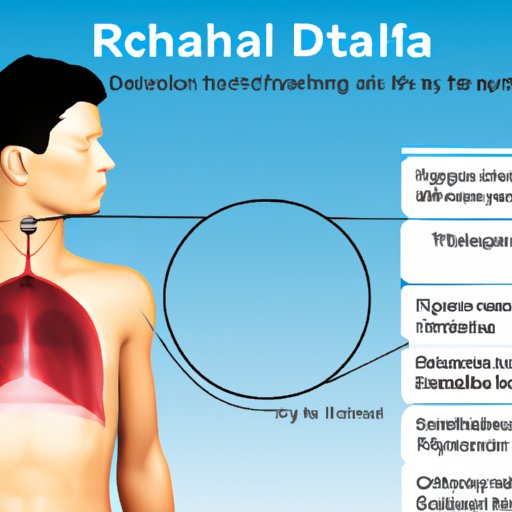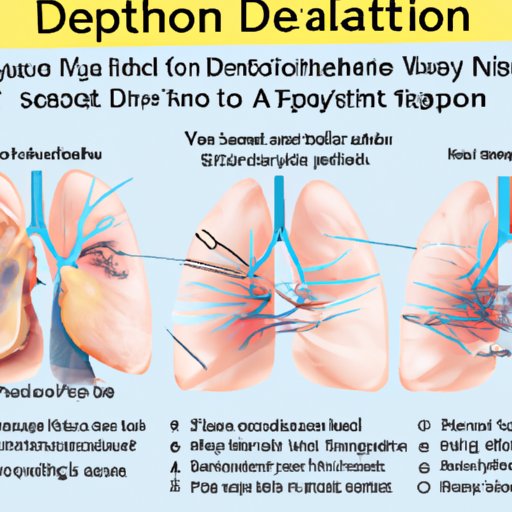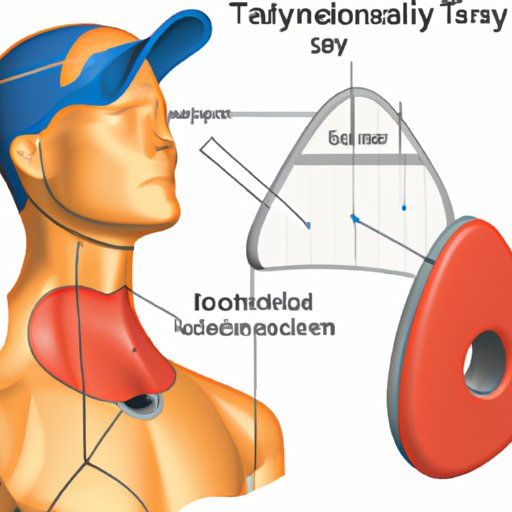Introduction
The diaphragm is an important part of the human body. It is a dome-shaped muscle located between the thoracic and abdominal cavities and is responsible for regulating our breathing. In this article, we will explore the anatomy and physiology of the diaphragm and how it works to help us breathe. We will also discuss how the diaphragm works during exercise, the effects of diaphragm dysfunction on breathing, and treatments for diaphragm disorders.
What is the Diaphragm?
The diaphragm is a thin sheet of skeletal muscle located between the thoracic and abdominal cavities. It is shaped like a dome and consists of three parts: the crura, the central tendon, and the costal portion. The crura are two curved sheets of muscle that attach the central tendon to the lumbar vertebrae. The central tendon is a thick band of connective tissue that attaches the crura and costal portions of the diaphragm to each other. The costal portion consists of muscle fibers that attach the diaphragm to the ribs.

Role of the Diaphragm in Breathing
The diaphragm plays an important role in the process of respiration. During inhalation, the diaphragm contracts, which causes the rib cage to expand and draw air into the lungs. When the diaphragm relaxes, the rib cage contracts and air is forced out of the lungs. This process is repeated as we breathe in and out. The diaphragm also helps to regulate our breathing rate by controlling the amount of air inhaled and exhaled.
How the Diaphragm Works During Exercise
During physical activity, the diaphragm works harder than usual to help increase oxygen uptake. As the body’s demand for oxygen increases, the diaphragm needs to contract more forcefully to draw in more air. This increased activity of the diaphragm helps to increase the amount of oxygen available to the muscles and organs. Other muscles such as the intercostal muscles and abdominal muscles also help to increase oxygen uptake during exercise by assisting with the expansion and contraction of the rib cage.

Effects of Diaphragm Dysfunction on Breathing
Diaphragm dysfunction can have a number of effects on breathing. People with diaphragm dysfunction may experience difficulty breathing, shortness of breath, fatigue, and chest pain. They may also be at risk for developing respiratory infections due to decreased airflow. People with diaphragm dysfunction may also be at risk for sleep apnea, a condition in which a person stops breathing for short periods of time during sleep.
Artificial Diaphragms
In some cases, people with weak respiratory muscles may need to use an artificial diaphragm. An artificial diaphragm is a device that is worn around the neck and is used to assist with breathing. It works by creating a vacuum inside the device which helps to draw air into the lungs. Artificial diaphragms can be beneficial for people with weak respiratory muscles, as they can help to improve oxygen uptake and reduce the symptoms of respiratory distress.
Treatments for Diaphragm Disorders
There are several treatment options available for diaphragm disorders. These include medications, physical therapy, breathing exercises, and surgery. Medications such as bronchodilators can help to open up the airways and make it easier to breathe. Physical therapy can help to strengthen the diaphragm and other respiratory muscles. Breathing exercises can also help to improve respiratory function. Surgery is usually only recommended for severe cases of diaphragm dysfunction.
Conclusion
The diaphragm is an important part of the human body and plays a vital role in breathing. It helps to regulate our breathing rate and increase oxygen uptake during exercise. Diaphragm dysfunction can have a number of negative effects on breathing, but there are treatments available to help manage the symptoms. Artificial diaphragms can also be used to assist with breathing in people with weak respiratory muscles. If you are experiencing any breathing difficulties, it is important to see your doctor for a proper diagnosis and treatment plan.
In conclusion, the diaphragm is an integral part of the human body and its anatomy and physiology are complex and fascinating. Understanding how the diaphragm works can help us better appreciate the importance of this muscle and the role it plays in our health.
Call to Action
If you are experiencing any breathing difficulties, it is important to talk to your doctor. Your doctor can diagnose any underlying conditions and provide the appropriate treatment to help manage your symptoms. Taking care of your respiratory health is essential for maintaining overall wellbeing.
(Note: Is this article not meeting your expectations? Do you have knowledge or insights to share? Unlock new opportunities and expand your reach by joining our authors team. Click Registration to join us and share your expertise with our readers.)
